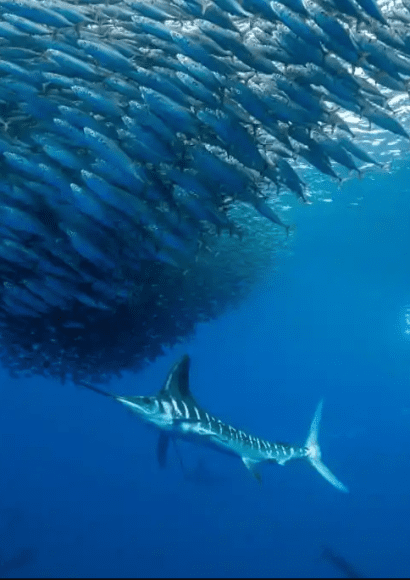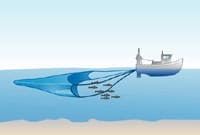
As the demand for seafood rises globally, so does the practice of trawling, a common fishing method. While trawling provides a significant portion of the world’s seafood, it comes at a considerable cost to the environment. This article delves into the intricate web of ecological consequences associated with trawling, shedding light on its impact on marine habitats, biodiversity, and the overall health of our oceans. Join us in unraveling the complexities surrounding “The Environmental Impact of Trawling” to understand the urgency of adopting sustainable fishing practices.
Contents
Understanding Trawling.
In the vast expanse of our oceans, a method known as live bait fishing has gained prominence, contributing significantly to the global seafood market. However, beneath the surface lies a complex tapestry of consequences, and understanding the nuances of trawling is essential to grasp its environmental impact.
Definition and Techniques of Trawling
Trawling, at its core, involves dragging a large net through the water, capturing fish in its path. Imagine it as a colossal fishing expedition, where a boat tows a net, much like a gigantic underwater vacuum cleaner. This method aims to catch a multitude of fish swiftly, but the repercussions extend beyond the immediate catch.
Transitioning into the techniques, trawling comes in various forms, each leaving a distinctive mark on our oceans. The utilization of live bait adds a dynamic element to this method, attracting fish to the trawl net. The bait, often smaller fish, serves as a lure, creating a frenzied feeding environment that facilitates a more efficient catch.
Types of Trawling – Unveiling the Depths
Trawling isn’t a one-size-fits-all approach; it manifests in different forms, each with its own set of consequences. Let’s dive into two prevalent types:
Bottom Trawling – Stirring the Ocean Floor
Picture the seafloor as a bustling neighborhood, with various species of marine life coexisting. Unfortunately, bottom trawling disrupts this harmony. This method involves dragging the net along the ocean floor, indiscriminately scooping up everything in its path. Imagine plowing through a garden, uprooting plants, and disturbing the delicate balance of the ecosystem.
Midwater Trawling – Casting a Wide Net
Now, consider midwater trawling as fishing in the open waters, away from the ocean floor. Here, the net is set at a specific depth to capture fish swimming in the middle of the water column. While seemingly less invasive than bottom trawling, it still poses challenges. Picture it as casting a wide net in the hope of catching specific fish, inadvertently ensnaring others in the process.
Ecological Consequences.🐟
In the vast expanse of our oceans, the environmental impact of trawling reverberates far beyond the surface, affecting marine life and ecosystems in profound ways. Let’s dive into the ecological consequences of this widespread fishing practice, exploring its effects on habitats, biodiversity, and the delicate balance of our oceans.
Habitat Destruction.
Imagine the seafloor as a bustling cityscape, teeming with life and vibrant ecosystems. However, the relentless drag of trawl nets sweeps across this underwater metropolis, leaving devastation in its wake. The once-thriving habitats of corals, sponges, and other marine organisms fall victim to the indiscriminate force of trawling, leading to irreparable habitat destruction. As these vital ecosystems crumble, the intricate web of life that depends on them begins to unravel, posing a threat to countless species of fish, crustaceans, and other marine creatures.
Bycatch Issues.
Beyond the targeted catch, the net of trawling often ensnares unintended victims in its grasp. This phenomenon, known as bycatch, brings to light the unintended consequences of indiscriminate fishing practices. Imagine a scenario where turtles, dolphins, and other non-target species become entangled in the mesh of trawl nets, facing injury or death as a result. The ripple effects of bycatch extend far beyond individual species, cascading through the ecosystem and disrupting fragile marine ecosystems.
Overfishing Concerns.
As trawling continues unabated, concerns over overfishing loom large on the horizon. The relentless pursuit of seafood through trawl fishing methods contributes to the depletion of fish populations, tipping the delicate balance of marine ecosystems. Picture a scenario where once-abundant fish stocks dwindle, leaving fishermen with dwindling catches and threatening food security for coastal communities worldwide. The unsustainable practices of trawling exacerbate the already precarious state of global fisheries, highlighting the urgent need for sustainable alternatives and conservation efforts.
Exploring Culinary Wonders Curiosities about Ceviche.
As we navigate the intricate web of environmental impacts associated with trawling, it’s fascinating to shift our focus momentarily to the world of culinary delights. One such culinary marvel that captivates both the taste buds and cultural heritage is ceviche.
Mitigation and Alternatives.🐟
In the wake of growing concerns over the environmental impact of trawling, it’s imperative to explore mitigation strategies and alternative fishing methods that prioritize the health of our oceans. Let’s delve into practical solutions and eco-friendly alternatives that aim to preserve marine ecosystem integrity while satisfying the world’s appetite for seafood.
Sustainable Trawling Practices.
Transitioning towards sustainable trawling practices is key to mitigating the adverse effects of this fishing method. By implementing measures such as mesh size regulation and area closures, fishermen can reduce bycatch and minimize habitat disruption. Additionally, the adoption of technologies like TEDs (turtle excluder devices) and BRDs (bycatch reduction devices) can further enhance the sustainability of trawl fisheries, allowing for targeted catches while minimizing environmental harm.

Alternatives to Trawling.
Diving deeper into the realm of fishing alternatives unveils a myriad of environmentally friendly options. From pole and line fishing to trap and pot fisheries, these methods offer more targeted approaches to catching seafood, reducing the ecological footprint associated with trawling. Embracing traditional fishing practices rooted in local communities and exploring innovative techniques like aquaculture can further diversify the seafood supply chain while promoting sustainability.
Empowering Change Through Education and Collaboration.
Educating fishermen, consumers, and policymakers about the importance of sustainable fishing practices is paramount in fostering positive change. By raising awareness about the environmental impact of trawling and highlighting the benefits of alternative methods, we can inspire collective action towards preserving our marine ecosystems for future generations.
Exploring the Unknowns.🐟
In this section, we will delve into the crucial questions surrounding the practice of trawling, exploring not only the direct impacts but also alternatives and the possibility of sustainable trawling. As an expert in marine life and fisheries, I will precisely address each question to provide a comprehensive understanding.
How does trawling affect marine life?
Trawling, by dragging large nets across the ocean floor, exerts significant pressure on marine habitats. This method can lead to the destruction of critical habitats, such as coral reefs and algae beds. Additionally, the incidental capture of unwanted species, also known as bycatch, can result in biodiversity loss and impact populations of key species in the food chain.
What are the alternatives to trawling?
There are several more sustainable alternatives to trawling. Methods like pole and line fishing, traps, and pots, as well as well-managed aquaculture, offer more selective and less harmful approaches to marine ecosystems. The adoption of technologies like turtle excluder devices and bycatch reduction devices can further improve the sustainability of fishing, allowing for targeted catches and reducing negative impacts.
Can trawling be sustainable?
Achieving sustainability in trawling is a challenge, but not impossible. The implementation of more selective fishing practices, mesh size regulation, and the adoption of modern technologies are steps toward sustainability. Additionally, education and awareness among fishermen and consumers are crucial to driving changes towards a more sustainable trawling, where human needs are balanced with the preservation of marine ecosystems.

